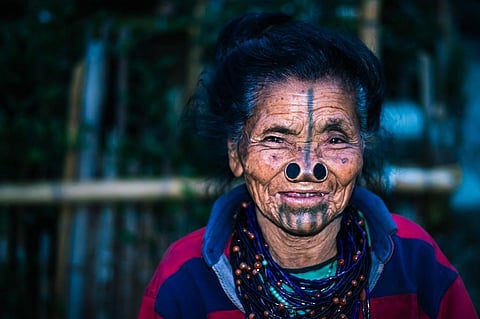Towards sustainability: Arunachal’s Apatanis use a unique, integrated cultivation method; it needs encouragement
The Apatanis, one of the major ethnic groups of the eastern Himalayas, practise a distinctive form of agriculture where rice and fish are grown together.
These farmers have been practising integrated rice-fish farming in their mountain terraces of Arunachal Pradesh since the 1960s.
The potential areas of rice-fish culture in the Apatani plateau are Napping, Yachuli, Ziro-II, Palin and Koloriang. Apatanis principally use three rice varieties: Emeo, Pyape and Mypia.
Also read: Vale of Apatanis
The total area of the Apatani Plateau is 10,135 square kilometres, where rice-fish culture is undertaken approximately in 592.0 hectares (ha) of irrigated rice lands out of 715.7 ha.
Apatani Plateau is a land of diverse cultures. The major festivals of Apatanis are the Myoko, Dree, Yapung and Murung. People here believe that these traditional festivals ensure better productivity and well-being.
Apatani Plateau has a climate ranging from humid subtropical to temperate. So, this plateau receives adequate rainfall during the summer season. The permeability and water-retaining capacity of the clayey, loamy soil favour this unique farming technique.
This integrated rice-fish cultivation is a low-input and eco-friendly practice. The stocked fish practically depend on the natural food sources of the rice fields and thus, farmers hardly need to use any supplementary fish feeds.
The farmers sometimes use household and agricultural wastes and excreta of domestic animals like pigs, cows, mithun (Bos frontalis) and goats to make farming more sustainable and organic.
Moreover, azolla and lemna are also grown in the field water as nitrogen fixers. The organic food grown in the field plays an essential role in feeding fish.
The water sources in these high-altitude rice fields are mountain streams and rainwater trickled down during the monsoon season.
Bamboo pipes are being used to distribute water from the networks of earthen irrigation channels using two outlet pipes. An outlet is fitted angularly at the upper level through a dyke to maintain the water level and another outlet is fitted at the bottom of the dyke to the exterior. It is used for dewatering the field during harvest.
Men and women perform different farm duties while preparing the fields for cultivating rice. And during the culture of fish, women folk participate as the major workforce.
Ancient and old-fashioned agricultural technologies are utilised for cultivation. Modern tools like tractors and power tillers are not affordable as well as inaccessible to the farmers.
They mostly use agricultural tools such as Dao (sickle) and dibbling sticks. After preparing the field, they transplant a maximum of two-three healthy rice plants with an average distance of 26 cm from each other.
Fish refuges are also created inside the fields. Three strains of fish species of common carp — Cyprinus carpiospecularis, Cyprinus carpio communis, Cyprinus carpionudus — are stocked just after ten days from transplanting rice.
The stocked fish are harvested twice in a season. The first and second or final harvest is done in the middle of July and October, respectively. But the rice is harvested at the end of September until the mid of October, i.e. once in a season.
Four cultivars of rice are grown along with fish species of Cyprinus carpiol. The total productivity ranges from 300-500 kilograms of fish per hectare in one season (ha-1 season-1) and 3,000-4,000 kg of rice (ha-1 season-1).
Fish enhances rice productivity (by 10-15 per cent) by controlling the growth of algae, weeds and insects, providing nutrient input through fish excreta and promoting tillering of the rice through the movement of fish inside the field.
Further, the mineralisation of organic matter, puddling of mud and soil aeration by other benthos enhances rice yield here. The records of rice and fish yields were obtained from the farmers through personal interviews.
Dykes at a higher elevation and lower elevation are constructed with a height of 0.9 m to 1.5 m and 0.4 to 0.6 m. These dykes are also used to remove water from the field during harvesting. Bamboo fencing is done to avoid the escape of fish through the pipes.
This eco-friendly and economically beneficial practice has made the system unique in terms of aquatic resource utilisation.
The zooplankton and algal life forms serve as natural food sources for the fish in the flooded rice fields to enhance aquatic productivity. This ecosystem service, in turn, indirectly maintains healthy human-made swamps with better livelihood options for tribal framers.
Field water depth is the limiting factor. All the agro-inputs in this ecosystem with organic manures, decomposed rice stubbles and macrophytes, along with other biotic and abiotic factors, regulate their various population properties in the inundated rice fields.
For growth and development, the stocked fish in the rice field may have utilised and assimilated available aquatic biomass and zooplankton through trophic interactions.
Therefore, high-altitude flooded environments enriched with such natural fish feeds have sufficient scope to raise fish as a concurrent crop of rice in the same field.
In the context of plankton and other fish food organisms, the wet rice fields are still data deficient. The water quality parameters, community structure and population dynamics of algal life forms under the rice canopy are favourable for the growth and abundance of zooplankton, which greatly influences the fish yield.
Therefore, such unique integrated farming systems require special attention for better productivity and profitability to the small-scale rural farmers in Assam and other northeastern hill states.
Read more:
Views expressed are the authors’ own and don’t necessarily reflect those of Down To Earth

